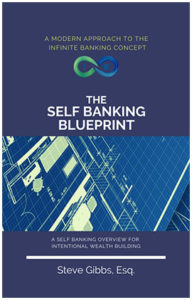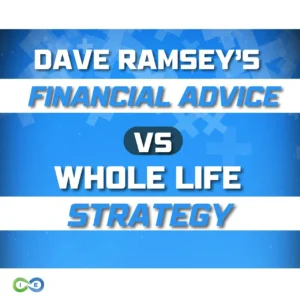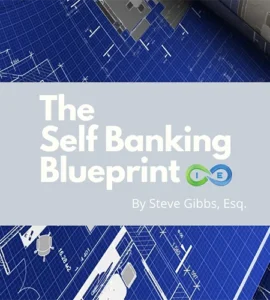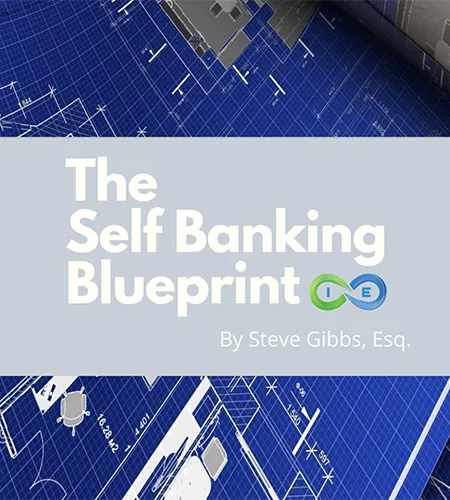About the Author
Steve Gibbs, JD, AEP® is CEO and Co-Founder of Insurance and Estate Strategies LLC. With 15+ years of estate planning experience as a licensed attorney in multiple states, Steve specializes in strategic life insurance design and wealth transfer strategies. He holds the prestigious AEP® certification for multi-disciplinary estate planning expertise and is a Penn Mutual Century Club award recipient.
TL;DR – Key Takeaways
The Bottom Line: After 35+ years of data, the 401k plan has significant flaws that weren’t apparent when it launched. While employer matching provides some benefit, the disadvantages often outweigh the advantages for many participants.
- Major Problems: Market volatility, higher taxes at withdrawal, early access penalties, hidden fees averaging 2.5% annually, and mandatory distributions
- Better Alternatives Exist: Cash value whole life insurance offers tax-free access, guaranteed growth, and no government restrictions
- Expert Opinion: Even Ted Benna, the “Father of the 401k,” now says he would “blow up the existing structure and start over”
Is the 401k Plan a Scam? A Comprehensive Analysis of Pros and Cons
Having already written a comprehensive article on 401k withdrawal rules, this article focuses specifically on 401k pros and cons, including the historical context and why virtually all working-class Americans participate in these plans.
The primary question we’ll answer throughout this analysis is whether the 401k plan represents a wise investment strategy or if it’s fundamentally flawed in ways that harm participants’ long-term financial security.
Table of Contents
Why Financial Institutions Love the 401k
Before diving into the pros and cons analysis, it’s important to understand the business model that drives 401k promotion. Financial institutions have a significant financial incentive to encourage 401k participation that goes beyond helping you build wealth.
When you contribute to a 401k plan, financial institutions receive your money and the government’s tax deferral upfront. Since 401k contributions are made with pre-tax dollars, the tax savings create additional investable capital that benefits the financial institution immediately, while you won’t see your money again for potentially decades.
During that time, these institutions generate revenue through management fees, administrative costs, and investment returns on assets under management. You, meanwhile, bear all the market risk while paying fees that compound over time.
Key Insight: The 401k system creates a scenario where financial institutions get guaranteed revenue streams while participants assume all the investment risk and pay increasing fees over time.
401k Pros and Cons Overview
The 401k plan has been marketed as the cornerstone of American retirement planning for over three decades. However, with 35+ years of performance data now available, we can objectively evaluate whether these plans deliver on their promises.
The reality is more complex than the typical financial services marketing suggests. While 401k plans do offer some legitimate benefits, they also carry significant disadvantages that weren’t fully understood when the system was first implemented.
This analysis examines both sides objectively, but the weight of evidence suggests that for many participants, the drawbacks outweigh the benefits. Interestingly, you’d be hard-pressed to find wealthy individuals who built their fortunes primarily through 401k contributions—most use strategies like real estate wealth building with infinite banking instead.
401k Pros: The Limited Benefits
To provide a balanced analysis, let’s first examine the legitimate advantages of 401k participation. While these benefits are real, they’re often less significant than promotional materials suggest.
Employer Matching – The Primary Benefit
The employer match represents the most compelling reason to participate in a 401k plan. However, this benefit diminishes significantly over time in ways most people don’t realize.
| Time Period | Match Impact | Percentage of Total Value |
|---|---|---|
| Years 1-5 | Significant | 15-25% |
| Years 10-20 | Moderate | 5-10% |
| Lifetime Total | Minimal | ~1% |
Over a complete career, employer matching typically contributes only about 1% to your total account value. When you factor in taxes on withdrawal, the net benefit drops even further.
Other Promoted Benefits
The financial services industry promotes several additional 401k advantages, though each comes with significant caveats:
- Tax Deferral: Your contributions reduce current taxable income, but you’ll likely pay higher tax rates in retirement
- Forced Savings: Automatic payroll deduction creates discipline, but the infinite banking concept® offers more flexibility with similar automation
- Professional Management: Your investments are managed by professionals, though performance often lags market indices after accounting for fees
Key Takeaway: While 401k plans do offer some legitimate benefits, particularly employer matching in the early years, these advantages are often overstated and diminish significantly over time.
401k Cons: Seven Critical Problems
Now that we’ve covered the benefits objectively, let’s examine the substantial drawbacks that have become apparent after decades of real-world implementation. These problems weren’t fully understood when the 401k system launched, but the data is now clear.
Even Ted Benna, widely considered the “Father of the modern 401k,” has acknowledged these issues. In a candid assessment of his creation, Benna stated: “If I were starting over from scratch today with what we know, I’d blow up the existing structure and start over.”
Problem #1: Market Unpredictability and Risk
The first major issue with 401k plans is the inherent unpredictability of market-based returns. This volatility creates significant problems for retirement planning that become more severe as you approach and enter retirement.
Consider the historical performance of the S&P 500 index, which many 401k plans track or attempt to outperform (though most actively managed funds actually underperform by 2% annually):
| Decade | Inflation-Adjusted Return | Market Volatility |
|---|---|---|
| 1960s | +5.6% | Moderate |
| 1970s | -1.4% | High |
| 1980s | +11.0% | Moderate |
| 1990s | +14.0% | Low |
| 2000-2010 | -40% (3 years), -37% (2008) | Extreme |
This data reveals a critical problem: you cannot predict your portfolio value with any degree of accuracy. An investor who relied on 401k returns from 1950-2008 averaged roughly 6.8% annually—not terrible over the long term, but with devastating drops during critical periods.
Critical Issue: If you’re 55-65 years old when the market crashes by 37-40%, you may never recover. The traditional advice to “ride out the storm” doesn’t work when you need the money for retirement.
Additionally, 401k withdrawals face a compounding tax problem. Unlike direct stock investments where you benefit from lower capital gains tax rates, all 401k distributions are taxed as ordinary income at higher rates.
There are alternatives that provide guaranteed minimum returns with upside potential, such as dividend paying whole life insurance, which eliminates the unpredictability while maintaining growth potential.
Problem #2: Tax Consequences on Withdrawals
The second major flaw in the 401k system relates to taxation. Most people are sold on the concept of “tax deferral” without understanding the long-term implications, which often work against the participant’s interests.
There are two critical tax issues that make 401k plans less attractive than commonly presented:
Higher Tax Rates on Ordinary Income
When you withdraw money from your 401k, every dollar is taxed as ordinary income rather than the more favorable capital gains rates. This creates a significant disadvantage compared to direct investing.
| Tax Treatment | Current Rates | Applied To |
|---|---|---|
| Capital Gains | 0%, 15%, 20% | Direct stock investments |
| Ordinary Income | 10% to 37% | 401k withdrawals |
Future Tax Rates Will Likely Be Higher
The assumption that you’ll be in a lower tax bracket in retirement is increasingly questionable. Here’s why:
- Inflation Impact: Inflation pushes you into higher tax brackets over time, requiring more dollars to purchase the same goods
- Fewer Deductions: Retirees typically have fewer tax write-offs than working professionals
- Government Debt: Rising national debt may force tax rate increases across all brackets
- Successful Saving: If you save successfully, your retirement income may actually be higher than your working years
Mathematical Example: Tax Deferral Reality
Let’s examine how tax deferral actually works in practice with a realistic example:
Example Scenario:
- Initial Investment: $50,000
- Time Period: 30 years
- Annual Return: 8% (generous assumption)
- Tax Bracket: 31% (both now and retirement)
401k Results:
– Pre-tax growth: $503,130
– After-tax value: $347,168 (31% tax on entire amount)
Taxable Account Results:
– After-tax contributions and growth: $250,620
Difference: $96,548 advantage to 401k
While this seems like a clear victory for the 401k approach, this example uses optimistic assumptions that rarely occur in reality. It doesn’t account for:
- Management fees (typically 1-3% annually)
- Higher future tax rates
- Reduced deductions in retirement
- State tax implications
- Mandatory distribution requirements
More importantly, there’s an even better option: cash value whole life insurance provides tax-deferred growth like a 401k, but allows tax-free access to your money without government restrictions.
Key Takeaway: While tax deferral sounds beneficial, the reality is that most 401k participants end up paying higher effective tax rates in retirement, especially when combined with ordinary income treatment and reduced deductions.
Problem #3: Early Access Penalties
The third major problem with 401k plans is the severe penalties for early access to your own money. This creates a fundamental problem: you’re essentially lending your money to the government with significant restrictions on when and how you can use it.
The government charges a 10% penalty for accessing 401k funds before age 59.5, in addition to regular income taxes. This creates scenarios where accessing your own money becomes prohibitively expensive.
Real-World Penalty Example
Consider a 55-year-old with $250,000 in their 401k who needs $25,000 for a legitimate purpose—perhaps a job relocation, business opportunity, or family emergency.
Penalty Breakdown for $25,000 Need:
- Required 401k withdrawal: $52,000
- Federal income tax (33%): $17,160
- State income tax (9%): $4,680
- Early withdrawal penalty (10%): $5,200
- Total cost: $27,040
- Net received: $24,960
This means you pay $27,040 to access $24,960 of your own money—a devastating 108% cost for early access. Additionally, your 401k balance drops by the full $52,000, creating a 20% reduction in your retirement account that could take 3-5 years to recover.
Most people choose to keep their money trapped in the 401k when confronted with these penalties, which means they can’t take advantage of opportunities or handle emergencies effectively.
A Better Alternative Exists
If the same person had a properly structured cash value life insurance policy with paid up additions, they could access $25,000 without any penalties or taxes through a policy loan.
The key advantage: their cash value continues to grow as if they hadn’t taken any loan out at all, while they have complete flexibility in repayment terms.
Critical Point: The 401k system forces you to pay outrageous fees to access your own money early, while alternatives like properly structured life insurance provide complete liquidity without penalties or taxes.
Problem #4: Hidden Fees That Compound Over Time
The fourth major issue with 401k plans is the complex web of hidden fees that can consume nearly one-third of your investment returns over a lifetime. These fees are deliberately obscured, making it difficult for participants to understand the true cost of their retirement plan.
According to research firm Demos, “over a lifetime, fees can cost a median-income two-earner family nearly $155,000 and consume nearly one-third of their investment returns.”
The Complexity Problem
The U.S. Department of Labor has created a 20-page report just to identify and explain all the possible fees in a 401k plan. This complexity is intentional—it makes it nearly impossible for participants to understand what they’re actually paying.
The fee structure typically includes multiple layers of charges:
- Sales charges: Also known as commissions or loads
- Management fees: Investment advisory fees and account maintenance fees
- Administrative fees: Separate charges for investment managers, trustees, recordkeepers, and communication firms
- Expense ratios: The percentage of your account charged annually
| Fee Type | Typical Range | Annual Impact on $100k |
|---|---|---|
| Expense Ratio | 0.5% – 2.0% | $500 – $2,000 |
| Administrative Fees | 0.3% – 0.8% | $300 – $800 |
| Other Fees | 0.2% – 0.7% | $200 – $700 |
| Total Annual Fees | 1.0% – 3.5% | $1,000 – $3,500 |
The Compounding Impact
Small differences in fees create massive differences in final account values. The Department of Labor’s own example demonstrates how a 1% difference in fees results in a 28% difference in final account value over 35 years:
Fee Impact Example (35-year investment period):
- Lower fee account (1.5% total fees): $227,000 final value
- Higher fee account (2.5% total fees): $167,000 final value
- Difference: $60,000 (28% reduction)
The situation becomes even worse when you consider the real-world performance data. According to Demos research, the average mutual fund return is 7%, but after fees, participants receive only 4.5%. When you add taxes on withdrawal, your effective return drops to approximately 3.5%—barely keeping pace with inflation.
Reality Check: After fees and taxes, most 401k accounts barely beat inflation over the long term, meaning your purchasing power doesn’t actually increase significantly despite decades of contributions.
Problem #5: Required Mandatory Distributions (RMDs)
The fifth problem with 401k plans is the government’s requirement that you withdraw money whether you need it or not. At age 73 (recently changed from 70.5), you must begin taking Required Minimum Distributions (RMDs) and paying taxes on them.
This requirement exists because the government wants to collect the taxes they’ve been deferring for decades. They don’t want you sitting on tax-deferred money indefinitely, so they force withdrawals regardless of your financial needs or market conditions.
Why RMDs Create Problems
According to major financial institutions, over half of 401k account holders don’t take their required distributions until after November 1st each year. This delay suggests that many people don’t actually need the money but are forced to withdraw it anyway.
The problems with forced distributions include:
- Unwanted Tax Liability: You must pay income taxes on distributions you don’t need
- Poor Market Timing: You might be forced to withdraw during market downturns
- Loss of Control: Your retirement planning becomes dictated by government requirements rather than your actual needs
- Escalating Amounts: RMD percentages increase each year, forcing larger withdrawals as you age
| Age | Required Distribution % | $500k Account Withdrawal |
|---|---|---|
| 73 | 3.65% | $18,250 |
| 80 | 5.35% | $26,750 |
| 90 | 8.77% | $43,850 |
The Penalty for Non-Compliance
If you fail to take your required distribution, the IRS imposes a 50% penalty tax on the amount you should have withdrawn. This creates a no-win situation where you’re forced to take distributions and pay income taxes, or face an even more severe penalty.
In contrast, those who use life insurance for retirement planning never face mandatory distributions. They maintain complete control over when and how to access their money throughout their entire lifetime.
Key Takeaway: RMDs remove your control over retirement timing and force you to pay taxes on money you may not need, while alternative strategies preserve your flexibility indefinitely.
Problem #6: Vesting and Portability Issues
The sixth problem with 401k plans involves vesting schedules and portability limitations that can cost you thousands of dollars if you change jobs before becoming fully vested in your employer’s matching contributions.
While your own contributions are always 100% vested, employer matching funds typically follow a vesting schedule that can span several years. If you leave your job before becoming fully vested, you forfeit a portion or all of the employer contributions.
Common Vesting Schedules
| Years of Service | Cliff Vesting | Graded Vesting |
|---|---|---|
| 1 | 0% | 20% |
| 2 | 0% | 40% |
| 3 | 100% | 60% |
| 4 | 100% | 80% |
| 5 | 100% | 100% |
This creates a problematic dynamic where employees may feel trapped in jobs they want to leave, simply to avoid losing employer matching contributions. It also means that the “free money” from employer matching isn’t actually free—it comes with strings attached that limit your career flexibility.
The Modern Career Reality
Today’s workers change jobs more frequently than previous generations. The Bureau of Labor Statistics reports that the median employee tenure is just 3.9 years. This means many workers never reach full vesting, particularly with cliff vesting schedules that require 3+ years of service.
When you combine vesting limitations with the other problems we’ve discussed, the employer matching benefit becomes much less valuable than initially presented.
Problem #7: The Salary Reduction Reality
The seventh and perhaps most philosophical problem with 401k plans is that they represent a fundamental trade-off: you’re exchanging current financial flexibility for uncertain future benefits. This is essentially a “life deferral plan” where you postpone financial opportunities today for the promise of retirement security decades down the road.
When you contribute to a 401k, you’re making several implicit decisions:
- Reduced Current Cash Flow: Less money available for current opportunities, emergencies, or quality of life improvements
- Opportunity Cost: Missing potential business investments, real estate opportunities, or other wealth-building strategies
- Control Transfer: Giving investment control to fund managers rather than directing your own financial decisions
- Timeline Rigidity: Locking money away until age 59.5, regardless of life circumstances
Consider This: The 401k system asks you to trust that government tax policy, market performance, and your personal circumstances will align favorably 20-40 years in the future. That’s a lot of variables outside your control.
Many successful entrepreneurs and investors argue that having access to capital when opportunities arise is more valuable than the theoretical tax benefits of deferral. The ability to act on opportunities—whether in business, real estate, or other investments—often produces better long-term results than passive 401k participation.
Key Takeaway: The 401k system requires you to sacrifice current financial flexibility and opportunity for uncertain future benefits, while alternatives allow you to build wealth without giving up control or liquidity.
Better Alternatives to Consider
Now that we’ve examined the significant problems with traditional 401k planning, it’s important to discuss superior alternatives that address these issues while providing better long-term results.
The key is to find strategies that offer:
- Tax advantages equal to or better than 401k plans
- Guaranteed growth with upside potential
- Complete liquidity without penalties
- No government restrictions or mandatory distributions
- Lower fees and more control
Cash Value Whole Life Insurance: The Superior Alternative
Properly structured cash value whole life insurance addresses every major problem we’ve identified with 401k plans while providing additional benefits.
Here’s how it compares:
| Feature | 401k Plan | Whole Life Insurance |
|---|---|---|
| Tax Treatment | Tax-deferred, taxed on withdrawal | Tax-free access via loans |
| Early Access | 10% penalty + taxes | No penalties or taxes |
| Market Risk | 100% market exposure | Guaranteed growth + dividends |
| Mandatory Distributions | Required at age 73 | Never required |
| Fees | Hidden, complex, ongoing | Transparent, built-in |
| Death Benefit | Account value only | Tax-free death benefit |
The Infinite Banking Concept
Taking the life insurance strategy further, becoming your own banker through the Infinite Banking Concept allows you to:
- Finance Your Own Purchases: Instead of paying interest to banks, you pay interest to yourself
- Build Wealth Continuously: Your money grows even when borrowed against
- Maintain Complete Control: No government restrictions or requirements
- Create a Family Legacy: Tax-free death benefits for your heirs
Real-World Advantage: With properly structured whole life insurance, you can access your money for any purpose—business opportunities, real estate investments, family needs—without penalties, taxes, or government approval.
Other Strategies Worth Considering
Depending on your situation, other alternatives may also be appropriate:
- Real Estate Investment: Real estate wealth building with infinite banking combines property appreciation with tax advantages
- Business Ownership: Building a business provides more control and potentially higher returns than stock market investing
- Direct Stock Investment: Better tax treatment through capital gains rates, though with market risk
- Roth IRA Conversion Strategies: For those who must use retirement accounts, strategic Roth conversions can improve outcomes
Key Takeaway: Multiple superior alternatives exist that provide better tax treatment, more control, guaranteed growth, and complete liquidity without the problems inherent in 401k plans.
Understanding Opportunity Cost
One of the most significant but invisible problems with 401k plans is the opportunity cost of locking your money away for decades. You’ll never see what you could have accomplished with that capital if you had maintained control and liquidity.
Consider these missed opportunities that 401k participants typically face:
- Business Investments: Unable to fund promising business opportunities due to locked-up capital
- Real Estate Deals: Missing real estate investments that require quick action and cash availability
- Family Needs: Can’t help children with education, home purchases, or business ventures without severe penalties
- Market Timing: Unable to take advantage of market dislocations or unique investment opportunities
The 401k system’s fundamental assumption is that passive, long-term stock market investing will outperform active wealth-building strategies. However, most wealthy individuals built their fortunes through business ownership, real estate investment, and strategic leverage—not through 401k contributions.
Wealth Reality Check: You won’t find many millionaires who built their wealth primarily through 401k plans. Most used strategies that provided control, leverage, and the ability to act on opportunities as they arose.
Conclusion: Making an Informed Decision
After examining 35+ years of real-world data and performance, the evidence suggests that 401k plans have significant structural problems that weren’t apparent when they were first introduced. While these plans do offer some benefits, particularly employer matching in the early years, the disadvantages often outweigh the advantages for many participants.
The seven major problems we’ve discussed—market unpredictability, tax consequences, early access penalties, hidden fees, mandatory distributions, vesting limitations, and opportunity costs—create a system that benefits financial institutions more than participants.
The Expert Consensus
It’s telling that Ted Benna, the “Father of the modern 401k,” now acknowledges that the system needs to be completely rebuilt. His candid admission that he would “blow up the existing structure and start over” speaks volumes about the fundamental flaws in the current approach.
Similarly, you won’t find many truly wealthy individuals who built their fortunes through 401k contributions. Most successful people use strategies that provide more control, better tax treatment, and the flexibility to act on opportunities.
A Path Forward
The good news is that better alternatives exist. Whether through properly structured whole life insurance investments, real estate, business ownership, or other strategies, you can build wealth without accepting the limitations and risks of traditional 401k plans.
The key principles for any superior strategy should include:
- Control: You maintain decision-making authority over your money
- Liquidity: Access to your capital when opportunities arise
- Tax Efficiency: Equal or better tax treatment than 401k deferral
- Guaranteed Growth: Protection from market volatility
- Transparency: Clear understanding of costs and benefits
Take Action Today
If you’re tired of following the conventional 401k approach and want to explore strategies that provide more control, better tax treatment, and guaranteed growth, we can help.
Contact Insurance and Estate Strategies LLC to learn about alternatives that allow you to build wealth without sacrificing liquidity or accepting unnecessary risk.
Ready to take control of your financial future? Schedule a consultation to discuss how strategies like the Infinite Banking Concept can provide the predictability and flexibility that 401k plans cannot match.
Learn the strategies wealthy families use to build and preserve wealth outside the traditional 401k system.
Final Thoughts: It’s Your Money, Your Choice
The 401k system asks you to trust that market performance, government tax policy, and your personal circumstances will align favorably decades in the future. That represents an enormous amount of uncertainty and variables outside your control.
You have the right to explore alternatives that provide more certainty, control, and flexibility. Don’t let conventional wisdom prevent you from investigating strategies that could serve your family’s interests better than the traditional retirement planning approach.
The evidence is clear: after 35+ years of real-world performance, the 401k system has significant structural flaws. The question isn’t whether these problems exist—it’s whether you’ll continue participating in a flawed system or explore better alternatives.
Final Takeaway: The 401k plan was an experiment that hasn’t delivered on its promises. You don’t have to continue participating in a system that benefits financial institutions more than participants. Better alternatives exist that provide more control, better tax treatment, and guaranteed growth without government restrictions.






4 comments
Falynne
If I currently have a 401k, but want to switch to cash value whole life insurance, is there a way to use those 401k funds to do so with as few penalties as possible?
Insurance&Estates
Hello Falynne, there are some options depending upon you age. You’re question was forwarded to Jason Herring who is an expert in this area. Feel free to reach out to him as well at jason@insuranceandestates.com.
Best, Steve Gibbs for I&E
Rick
I work at publics and have 10 percent of my weekly paycheck taken out to go into a voya account. I think they match it. Have to wait til i am older to enjoy it, i wonder if i should stop getting money taken out every week? And get the money now
Insurance&Estates
Hello Rick, thanks for reading and commenting. Without a thorough discussion of your goals, and a better understanding of you, it is tough to offer any strategic advice as every person and situation is different. Feel free to connect with Jason Herring at jason@insuranceandestates.com to pursue a more in depth discussion.
Best,
Steve Gibbs for I&E.